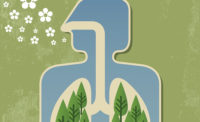Industrial sites pepper our landscape, often in clusters of industrial parks not far from residential areas. Important industries and utilities all over the U.S. are connected by a transportation infrastructure that makes access easy for anyone. Tighter security measures and increased vigilance have "hardened" industrial targets, but, depending on your type of facility and where it's located, you and your employees may need to be prepared with personal protective equipment (PPE).
Government and industry leaders agree: the key to being prepared for a disaster, terrorist-induced or otherwise, is readiness. The most important measures industry leaders can take are to assess, plan, prepare and train for an event BEFORE it happens. Let's look at some of the "readiness" challenges decision-makers may face and the resources that are available to them.
Respiratory-related
The Centers for Disease Control (CDC) has identified nine chemical/biological/radiological agents that terrorists are most likely to use. Of these nine, only botulism is a foodborne toxin. The rest either are spread through or directly attack the respiratory system. Consequently, much of the focus in surviving terrorist attacks is placed on respiratory protection.Despite the attention given to first responders, in cases of industrial terrorism, they may be second to respond. You and your workforce could be the first line of defense against weapons of mass destruction.
Suppose that your facility is attacked by terrorists using Sarin gas. Sarin is colorless, tasteless and odorless. When it is inhaled, low concentrations produce symptoms like a runny nose and watery eyes within seconds. With higher concentrations and increased exposure, more serious symptoms like convulsions, paralysis and fatal respiratory failure can occur.
Escape hoods
Yet Sarin is survivable. Properly fitted and donned gas masks equipped with NIOSH-approved CBRN (chemical/biological/radiological/nuclear) canisters can provide enough protection to allow you to move to a safe, fresh-air environment upwind of the attack zone.But gas masks require training and fit-testing programs for proper use, and many industrial facilities have no day-to-day need for them. A simple solution is an escape hood. Various styles of escape hoods all seem to have three characteristics in common:
1) They're intended for single use, so they are hermetically sealed and generally have a long shelf-life (four to five years);
2) They have fiber and activated-carbon filters to remove particulates (like anthrax spores and smallpox viruses) and gases from the inspired air stream;
3) To ensure that only filtered, respirable air gets to the user, the hood seals tightly around the wearer's neck by means of a silicone or latex neck dam.
For the average person, escape hoods have some advantages over gas masks. Product use requires minimal training. In most cases, users simply open the package and pull the hood over their head. Easy instructions are included.
Gas masks come in sizes and must be fitted to the wearer. Escape hoods are one-size-fits-all. Beards and eyeglasses that can interfere with a gas mask's seal aren't a problem with escape hoods. Neither is long hair. Almost anyone can wear an escape hood.
Other options
Still, gas masks and escape hoods are not the only respiratory protection products that can save lives in a CBRN attack. PAPRs (powered air-purifying respirators) and SCBAs (self-contained breathing apparatus) are also available. PAPRs have the advantage of using an electric fan or blower to draw air through the filters and into a facepiece or hood. PAPRs are easier to use than gas masks or escape hoods and could be the respirator of choice for workers with respiratory issues. By creating positive pressure inside the facepiece or hood, PAPRs virtually eliminate the need for a tight-fitting neck dam.
All air-purifying respirators (APRs), including gas masks, escape hoods and PAPRs, must be used in atmospheres with adequate oxygen. However, SCBAs use a compressed air supply, which makes them suitable in low-oxygen or smoke-filled environments. NIOSH provides a fact sheet that is helpful in selecting the best type of respirator for your particular application.
Lessening the impact
The Sarin attack scenario imagined above presumes an unguarded or inadequately filtered HVAC system. In April 2003, NIOSH published "Guidance for Filtration and Air-Cleaning Systems to Protect Building Environments from Airborne Chemical, Biological, or Radiological Attacks." The systems it describes can lessen the impact of an attack but may not provide a perfectly safe environment. This underscores the need for PPE.While it is impossible to prepare for all potential threats, other important guidelines can be obtained from a report: "Protecting Emergency Responders: Lessons Learned from Terrorist Attacks." Released by RAND Science and Technology Policy Institute and NIOSH, it summarizes discussions during a two-day NIOSH-sponsored conference held in New York City in December 2001.
The workshop assembled more than 150 participants, who represented firefighters, emergency medical services, law enforcement, safety equipment manufacturers, construction and other trade services, state and federal agencies, and health and safety professionals. A copy of the conference proceedings is available online (see "Readiness Resources" sidebar).
Recommended strategies
From those discussions come these recommendations to organizations and individuals who are developing Homeland Security strategies:
SIDEBAR: "Readiness" Resources
